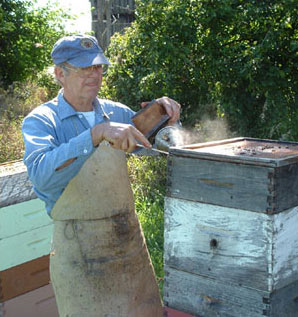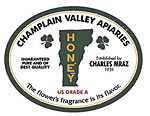Vermont Honey

A Vermont honey comb a rare sight in a store - you have to special order if you want one. Honey combs are said to contain additional nutrients.
Vermont produces about 500,000 pounds of honey annually, depending upon the weather conditions. Vermont's honey is produced from mainly wildflowers and forage feeds for cows. Because of the types of plants that grow in Vermont, Vermont honey is characteristically mild flavored and light colored.
Vermont's honey bees are a major contributor to the Vermont agricultural scene. They are engaged in an important polination service.
How Vermont Bees do their Work
The body of the bee is covered with very small branched hairs, that accumulate pollen grains as the bee flies from flower to flower gathering nectar. With each new flower visited, some pollen is inadvertently dropped off, and some is picked up. The bees then carry the nectar and pollen back to the hives to feed their young. Pollen is a bees' source of protein. Nectar provides the carbs. This process s vital to many plants, enabling them to re-produce and produce seeds and fruit. Many commercial crops need pollination. This is especially true for Vermont's Apple Orchards. Other Vermont crops that benefit from pollination include blueberries, raspberries, strawberries, pumpkins, squash and cucumbers.
How Honey is Made

Honey is a concentrated solution of simple sugars, mostly fructose and glucose manufactured by honeybees from the nectar of flowers. The foraging honeybee draws nectar up from the host flower's nectar glands and stores it temporarily in her honey crop. During the return flight to the hive, she adds enzymes to the nectar that begin to break down the nectar's sucrose into simpler sugars. Once bees in a hive have been alerted to a new honey source through several different and distinct dances, the foraging bees will "work" that source until it's exhausted. Then they will move on to another flower.
Unripened honey has a water content of between 50 and 75 percent, and would spoil if left as is. The honey must be protected from deterioration to be of use to a hive of bees, which may store it for months or even years before it needs to use the honey. So the bees quickly reduce the moisture to less than 18 percent by fanning their wings to circulate air throughout the hive. When the proper honey density has been reached the bees seal the finished product in cells with a wax capping.
There are approximately 1000 beekeepers who raise bees for honey in Vermont. Most are hobbyists and they don't have stores or websites. Most sell their honey in barrels at the wholesale level. Vermont's major honey retailer is :
Champlain Valley Apiaries
PO Box 127
Middlebury, VT 05753
 United States United States
Map It!
Web Site:
www.champlainvalleyhoney.com
Phone:(802) 388-7724
|